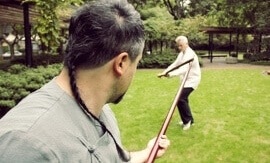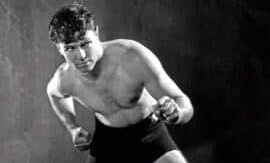
SIFU SHAUN RAWCLIFFE IS A WING CHUN INSTRUCTOR, CLOSE QUARTER COMBAT INSTRUCTOR, FORMER CLOSE PROTECTION OFFICER AND HAS BEEN ACKNOWLEDGED AND AWARDED THE COMBAT HALL OF FAME AWARD THREE TIMES.
He is also one of only 20 Wing Chun instructors to be certified by Ip Man’s son, Sifu Ip Chun. Almost 23 years with Ip Chun, he has written many articles, travelled to many seminars and has released two books. In the fall of 2012, Crowood Press will release his new book, Wing Chun Kung Fu: Weapons Training.
It seems that you have many branch schools. How do you keep a high standard of training?
I’m not a Wing Chun businessman and don’t have a full-time school or even teach for a living, so my schools have grown and developed naturally over the years. I actually don’t earn money from the schools—each branch is run financially independent. The benefit is that there is no real incentive to force the organisation to grow, therefore a new school or branch only opens if the instructor achieves (and maintains) an acceptable standard, and only if that instructor wishes to and is prepared to commit themselves to running a class. My reasons for teaching are purely selfish. First, by running a decent-sized set of classes, I could invite my Sifu to come to the UK. The students paying for the seminars would fund his airfare, hotel costs and food.
I would, therefore, get to spend time and have the opportunity to train with my teacher at a nominal cost to me. Secondly, as I can’t get to Hong Kong now more than once a year, I train up instructors to the highest possible standard so I have quality hands to train with. It’s a bit like tying pieces of meat to my training shoes and then releasing very hungry Rottweilers—my guys are always snapping at my heels so I have to keep on going! The final reason I teach is that at some point I will want to cut down on my classes and possibly just travel around teaching the instructors. To do that, I need to know that the classes I currently teach are left in the best possible hands so they continue to flourish.
You’ve been a long devotee of the Ip Man/Ip Chun line of Wing Chun and touched hands with many practitioners. Why have you decided to stay with your lineage? What has made your learning experience so special?
I have been very fortunate to study directly under Ip Chun Sifu for almost 23 years and I am one of only 20 instructors in the world certified as an instructor and representative. I have touched hands with many great Wing Chun Sifus and practitioners including Ip Ching, Wong Shun Leung, Lok Yui, Tsui Sheung Tin, Leung Ting, William Cheung, as well as many other practitioners. I’m not saying Ip Chun Sifu is a better teacher than any of the others, but I can say he is the best teacher for me. When I started training with him, I was working as a professional bodyguard, had earned a Black Belt in Shotokan Karate and had been teaching Wing Chun since 1982. I could already handle myself, but in him, I found someone who wasn’t going to try to make me apply Wing Chun “his” way. Instead, he was someone who refined and developed my toolset, allowing me to apply Wing Chun my way. Ip Chun Sifu is no great fighter, but he has the ability to look at your shape, structure or energy to refine and develop it. Personally, I didn’t want to study under someone who was fight oriented—that would have been like going to Mike Tyson to learn boxing! The problem is, a great fighter wouldn’t necessarily want or allow me to be better than them. Continuing the previous analogy, I wanted to go to the Wing Chun equivalent of Cus D’Amato—someone who would refine my art and toolset, and would help me reach my potential while having no agenda. I found that in Ip Chun Sifu. Today, at the age of 87, Sifu’s focus on Wing Chun is very health-related, so he focuses on Chi Sau and the forms. However, between 1989 and 1995, when I studied privately at his home, all my training was geared towards practicality. The techniques would be explored in the forms, in the Chi Sau drills, on the Wooden Dummy and occasionally, when another student was brought in, I explored how I may apply them against an “opponent”. The Wing Chun politics saddens me. True martial artists are supposed to be humble, honest, trustworthy individuals wanting to share their skills and knowledge, but there seems to be this minority who desire to put down, belittle, criticise and undermine anyone who doesn’t do the same style—those of a different lineage or even those within the same Wing Chun family.
With the rise of MMA, how do you see a traditional martial art like Wing Chun competing for the limelight?
I often get asked, “Why don’t you train against other martial arts styles? Why don’t you spar? Why don’t you use protective gear? Why don’t you enter competitions?” Well, let me start by saying that I highly respect and admire those that do. However, for me, the answer is simple—in Hong Kong, I was taught that Wing Chun’s reason d’être is practical street self-defence: no rules, no second chances, no referees, no corner-man, no protection, no tapping out and no instant medical treatment available. In the street, if it kicks off, you wouldn’t be trained to peak fitness for a fight you knew of months in advance. Your opponent wouldn’t be known to you, and you wouldn’t have studied their style from watching films of their previous fights. You may be fighting for survival or the protection of your nearest and dearest—certainly not for trophies, accolade or the prize money. You can’t really compare MMA to Wing Chun anymore than you can compare a tiger to a shark. Both great fighters, both ferocious if required—but where will they meet to fight? In the water? My money is on the shark. On land? I’m betting on the tiger.
In your first book, Simply… Wing Chun Kung Fu, you mention that Wing Chun is an internal art. Can you explain the complexity of Qi and how you use it with your Wing Chun?
As a Yorkshireman, I struggle with the concept of Qi. I believe in it and I even practise acupressure, but I am loath to talk about something I can’t adequately explain. Hence, I got one of my students, who practises acupuncture, to write about Qi energy used in Wing Chun in my first book. Personally, I prefer to talk about how Wing Chun redirects an opponent’s force using the correct musculoskeletal alignment. We use isolated muscle groups, such as the triceps, to maintain the correct elbow structure, angle and distance from the body in, say, Taan Sau. We control the length of the triceps so the Taan Sau structure doesn’t collapse, nor do we try to push the opponent’s attack away. At the same time, we maintain relaxed biceps. This can be explained as a musculoskeletal function or as a result of Qi energy being directed to the elbow to make it immovable while the bicep remains relaxed—two different explanations of the same function with the same result.
You will be releasing a book on the weapons of Wing Chun in the fall. What is the book called and what will it be about?
It is called Wing Chun Kung Fu: Weapons Training and it covers just that. It discusses the Baat Cham Dao and the Luk Dim Boon Kwun forms, the history, practicality (or lack thereof) and the benefits of training both these weapons. Like the other two books, it’s developed from the copious notes I made over the 38 training trips to Sifu in Hong Kong.
Where do you think the future of Wing Chun is headed and what role do you hope to play?
Wing Chun is growing exponentially, which is a double-edged sword. When I started studying Wing Chun in 1979, there were only a handful of Wing Chun schools in the UK. Now there is one on every street corner it seems. The upside is that Wing Chun is growing in popularity every day making it much more accessible. The downside is the lack of consistency of quality and the politics and potential rivalry this popularity brings. My part? Well, I hope to be a good ambassador for the art and promote Wing Chun as a style, rather than promote my schools or myself. If I promote our own school, only that school benefits, however, if we promote the style, every Wing Chun practitioner benefits. ![]()



















